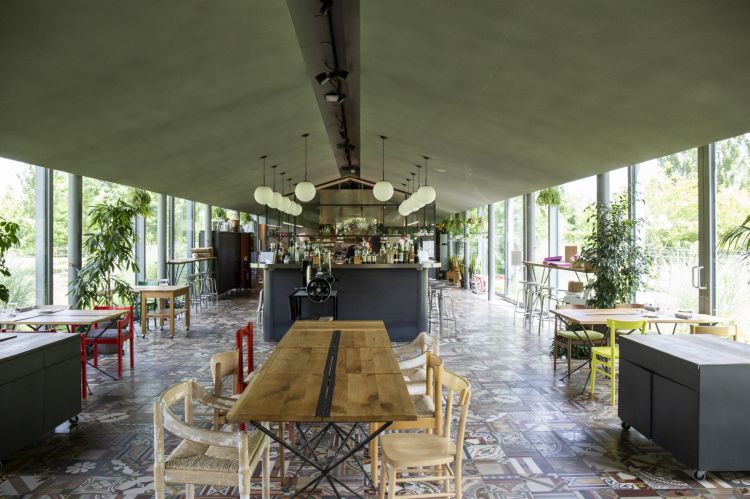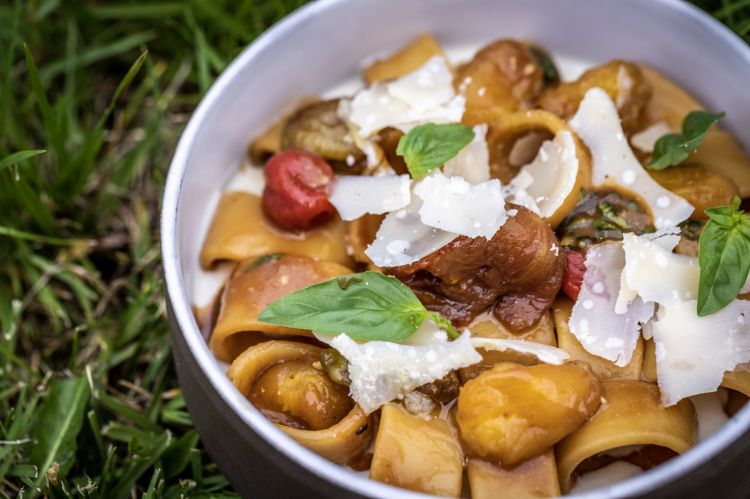If it wasn't we had an appointment, we would almost be happy of having lost our way among these luxurious and silent paths, on the border between the provinces of Venice and Treviso. After a couple of U-turns near the river Sile, here is the destination we were looking for: Le Cementine.
Behind the parking lot, not only one can find the greenest restaurant in the history of the Alajmos, but a constellation of establishments that is the result of a joint venture launched early this year between the Paduan family and H-Farm. H stands for “Human”, and it's a marvellous hub of innovation, research and training with facets that would deserve a separate post. Since we focus on good food, however, we will just give you some data: a total of 51 hectares, of which 40 of park and forest, and a capacity of 3000 people, what with staff, students, start-uppers and entrepreneurs. A hub that probably has no equal in Europe. For sure, no other campus in the Old Continent can match the same culinary offer. Let's see all the pieces of the J-Puzzle.
LE CEMENTINE. This is the most ambitious restaurant of the entire structure. It owes its name to the pretty Apulian cement tiles placed on the ground. The cement path is divided between a fresh pergola and a dining room with open-view kitchen surrounded by glass walls, that let the protagonists of this place enter the dining room scene: vegetables, fruits and herbs that grow lusciously all around. The menu, designed by Massimiliano Alajmo, shows an encouraging offer of “countryside cuisine” which would be curious to see as 100% vegetarian (trivia fact: Rita Alajmo, Max and Raf's mother, has been a vegetarian for over 30 years). But now the vegetable garden nicely shares its place with the sea, because if you go on a boat along the river Sile that flows nearby, in less than an hour you're in the middle of the Venetian Lagoon (where you can find the current family blockbuster, Hostaria in Certosa). The executive chef at Le Cementine, Mattia Ercolino, born locally but originally from Naples, gives his interpretation to the offer which, through emblematic dishes (the magnificent interpretations of Orto extravergine or Maxpacho di pesche), new dishes (Cold Spaghetti with raw fish and tomato and basil) or meat-based ones (soon we will see dad Erminio serving his legendary tartare) never neglects flavours, which are full and very neat behind the bucolic allure. And he also makes an effort to apply all those tricks that minimise food waste. We can bet some green stars will be coming soon.

The boulevard leading to the entrance of Cementine

The vegetable garden at Le Cementine

Le Cementine, a detail of the dining room (photo by Lido Vannucchi)

Ercolino and Michela Gobbo, dining room manager after the opening of Sesamo in Marrakech

The welcome at Le Cementine: left to right, Cream of peas aromatised with basil, Oil and tomato confit, Reduced onion spring broth with thyme, and Courgette carpaccio with mulberries from the garden

Orto extravergine, a masterpiece in which the tomato acquires many shapes: sorbet of yellow and red date tomatoes, gelatine of tomato water, cold purée, tartare, raw tomato, panzanella, cream of broad beans and French beans

Calamari of pasta with roasted dates, shaved Parmigiano and sauce of smoked ricotta (photo from Filippo Noventa)

Cold spaghetti with raw fish with tomato and basil

Chicken in a hot sauce, with potatoes and oyster sauce

Crispy hazelnut and coffee tiramisu

Chocolate langue de chat and curry puff pastries. Le Cementine has an à la carte menu, and two tasting menus for 75 and 95 euros
. Five minutes of zigzagging by car in the middle of the nature and we're in the real H-Farm. In the distance, we can see another glass building. The same sordid venetian gold masks that
Philippe Starck had stuck on
Amor in Corso Como in Milan, a project that was never successful and has now ended, are hanging here. It's
Amor in Farm, an establishment that moves the steam pizza module here to Treviso and extends it to very different spaces (two levels and a large dehors) and many “fast-casual” options in the menu, from the steamed
Mask.calzini and
Mask.calzoni (sweet and savoury) to Hot-dogs (and veg-dogs), burgers and salads. We can imagine students crowding this place from all day long, ready to plunder the pantry at
In.Gredienti (in our case, we got a compact
Torta Gianduja and some curry biscuits to nibble like they were olives during an aperitivo).
LA SERRA. After Hostaria Certosa, the Alajmos take on the task of another format with large numbers, in this case something closer to a canteen. It's the
Serra, the new-born building at H-Farm which at the moment, because of Covid, can host a maximum of 168 students but would normally welcome 50% more. A laid-back place, with botanic, luscious furniture, comfortable chairs and plugs on the walls where you can spend hours chatting, working and eating high quality salads and snacks for a low price. Open all day long. A fascinating challenge for the horizons it could open.
PIZZERIA AL 4. And then there's more pizza, but with a more classic format, at Pizzeria al 4. Classic so to speak, since Massimiliano Alajmo's menu, while waiting for the pizza, offers Treccioni di mozzarella and cherry tomatoes, Smoked Angus Carpaccio with oil, or properly made Fried courgette flowers. And then come the round pizzas, classic, vegan (the Marrakech has chickpea hummus, onion in balsamic vinegar, herbs, cumin and tandoori), on the peel, wholewheat or made in the pan. A complete selection.

A segment of the Campus. H-Farm welcomes children and students, from kindergarten to university
To these four projects we should add a fifth one, the catering for H-Farm's events, which is about to start again. Five projects that must be added to Calandre and Calandrino in Sarmeola, the Quadri triptych in Venice (Ristorante on the first floor, Gran Caffè in the square and Quadrino on the ground floor, indoors), Hostaria Certosa and Amo also in Venice. And then Caffè Stern in Paris (opening on the 15th of September) and Sesamo in Marrakech... It's difficult to find in Italy such an intertwined mix in terms of quality and quantity.
Translated into English by Slawka G. Scarso